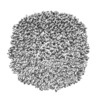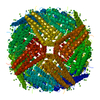[English] 日本語
 Yorodumi
Yorodumi- EMDB-20837: Equine spleen apoferritin prepared with the Shake-it-off device -
+ Open data
Open data
- Basic information
Basic information
| Entry | Database: EMDB / ID: EMD-20837 | |||||||||
|---|---|---|---|---|---|---|---|---|---|---|
| Title | Equine spleen apoferritin prepared with the Shake-it-off device | |||||||||
 Map data Map data | apoferritin prepared by the shake-it-off device | |||||||||
 Sample Sample |
| |||||||||
| Function / homology |  Function and homology information Function and homology informationferritin complex / autolysosome / ferric iron binding / autophagosome / iron ion transport / ferrous iron binding / cytoplasmic vesicle / intracellular iron ion homeostasis / iron ion binding / cytoplasm Similarity search - Function | |||||||||
| Biological species |  | |||||||||
| Method | single particle reconstruction / cryo EM / Resolution: 2.6 Å | |||||||||
 Authors Authors | Rubinstein JL / Guo H / Ripstein ZA / Benlekbir S | |||||||||
| Funding support |  Canada, 1 items Canada, 1 items
| |||||||||
 Citation Citation |  Journal: Acta Crystallogr D Struct Biol / Year: 2019 Journal: Acta Crystallogr D Struct Biol / Year: 2019Title: Shake-it-off: a simple ultrasonic cryo-EM specimen-preparation device. Authors: John L Rubinstein / Hui Guo / Zev A Ripstein / Ali Haydaroglu / Aaron Au / Christopher M Yip / Justin M Di Trani / Samir Benlekbir / Timothy Kwok /  Abstract: Although microscopes and image-analysis software for electron cryomicroscopy (cryo-EM) have improved dramatically in recent years, specimen-preparation methods have lagged behind. Most strategies ...Although microscopes and image-analysis software for electron cryomicroscopy (cryo-EM) have improved dramatically in recent years, specimen-preparation methods have lagged behind. Most strategies still rely on blotting microscope grids with paper to produce a thin film of solution suitable for vitrification. This approach loses more than 99.9% of the applied sample and requires several seconds, leading to problematic air-water interface interactions for macromolecules in the resulting thin film of solution and complicating time-resolved studies. Recently developed self-wicking EM grids allow the use of small volumes of sample, with nanowires on the grid bars removing excess solution to produce a thin film within tens of milliseconds from sample application to freezing. Here, a simple cryo-EM specimen-preparation device that uses components from an ultrasonic humidifier to transfer protein solution onto a self-wicking EM grid is presented. The device is controlled by a Raspberry Pi single-board computer and all components are either widely available or can be manufactured by online services, allowing the device to be constructed in laboratories that specialize in cryo-EM rather than instrument design. The simple open-source design permits the straightforward customization of the instrument for specialized experiments. | |||||||||
| History |
|
- Structure visualization
Structure visualization
| Movie |
 Movie viewer Movie viewer |
|---|---|
| Structure viewer | EM map:  SurfView SurfView Molmil Molmil Jmol/JSmol Jmol/JSmol |
| Supplemental images |
- Downloads & links
Downloads & links
-EMDB archive
| Map data |  emd_20837.map.gz emd_20837.map.gz | 20.9 MB |  EMDB map data format EMDB map data format | |
|---|---|---|---|---|
| Header (meta data) |  emd-20837-v30.xml emd-20837-v30.xml emd-20837.xml emd-20837.xml | 15.7 KB 15.7 KB | Display Display |  EMDB header EMDB header |
| Images |  emd_20837.png emd_20837.png | 83.4 KB | ||
| Masks |  emd_20837_msk_1.map emd_20837_msk_1.map | 22.2 MB |  Mask map Mask map | |
| Others |  emd_20837_half_map_1.map.gz emd_20837_half_map_1.map.gz emd_20837_half_map_2.map.gz emd_20837_half_map_2.map.gz | 20.3 MB 20.3 MB | ||
| Archive directory |  http://ftp.pdbj.org/pub/emdb/structures/EMD-20837 http://ftp.pdbj.org/pub/emdb/structures/EMD-20837 ftp://ftp.pdbj.org/pub/emdb/structures/EMD-20837 ftp://ftp.pdbj.org/pub/emdb/structures/EMD-20837 | HTTPS FTP |
-Validation report
| Summary document |  emd_20837_validation.pdf.gz emd_20837_validation.pdf.gz | 79.1 KB | Display |  EMDB validaton report EMDB validaton report |
|---|---|---|---|---|
| Full document |  emd_20837_full_validation.pdf.gz emd_20837_full_validation.pdf.gz | 78.2 KB | Display | |
| Data in XML |  emd_20837_validation.xml.gz emd_20837_validation.xml.gz | 496 B | Display | |
| Arichive directory |  https://ftp.pdbj.org/pub/emdb/validation_reports/EMD-20837 https://ftp.pdbj.org/pub/emdb/validation_reports/EMD-20837 ftp://ftp.pdbj.org/pub/emdb/validation_reports/EMD-20837 ftp://ftp.pdbj.org/pub/emdb/validation_reports/EMD-20837 | HTTPS FTP |
-Related structure data
| Similar structure data |
|---|
- Links
Links
| EMDB pages |  EMDB (EBI/PDBe) / EMDB (EBI/PDBe) /  EMDataResource EMDataResource |
|---|---|
| Related items in Molecule of the Month |
- Map
Map
| File |  Download / File: emd_20837.map.gz / Format: CCP4 / Size: 22.2 MB / Type: IMAGE STORED AS FLOATING POINT NUMBER (4 BYTES) Download / File: emd_20837.map.gz / Format: CCP4 / Size: 22.2 MB / Type: IMAGE STORED AS FLOATING POINT NUMBER (4 BYTES) | ||||||||||||||||||||||||||||||||||||||||||||||||||||||||||||||||||||
|---|---|---|---|---|---|---|---|---|---|---|---|---|---|---|---|---|---|---|---|---|---|---|---|---|---|---|---|---|---|---|---|---|---|---|---|---|---|---|---|---|---|---|---|---|---|---|---|---|---|---|---|---|---|---|---|---|---|---|---|---|---|---|---|---|---|---|---|---|---|
| Annotation | apoferritin prepared by the shake-it-off device | ||||||||||||||||||||||||||||||||||||||||||||||||||||||||||||||||||||
| Projections & slices | Image control
Images are generated by Spider. | ||||||||||||||||||||||||||||||||||||||||||||||||||||||||||||||||||||
| Voxel size | X=Y=Z: 1.06 Å | ||||||||||||||||||||||||||||||||||||||||||||||||||||||||||||||||||||
| Density |
| ||||||||||||||||||||||||||||||||||||||||||||||||||||||||||||||||||||
| Symmetry | Space group: 1 | ||||||||||||||||||||||||||||||||||||||||||||||||||||||||||||||||||||
| Details | EMDB XML:
CCP4 map header:
| ||||||||||||||||||||||||||||||||||||||||||||||||||||||||||||||||||||
-Supplemental data
-Mask #1
| File |  emd_20837_msk_1.map emd_20837_msk_1.map | ||||||||||||
|---|---|---|---|---|---|---|---|---|---|---|---|---|---|
| Projections & Slices |
| ||||||||||||
| Density Histograms |
-Half map: Half map B - from cryoSPARC
| File | emd_20837_half_map_1.map | ||||||||||||
|---|---|---|---|---|---|---|---|---|---|---|---|---|---|
| Annotation | Half map B - from cryoSPARC | ||||||||||||
| Projections & Slices |
| ||||||||||||
| Density Histograms |
-Half map: Half map A - from cryoSPARC
| File | emd_20837_half_map_2.map | ||||||||||||
|---|---|---|---|---|---|---|---|---|---|---|---|---|---|
| Annotation | Half map A - from cryoSPARC | ||||||||||||
| Projections & Slices |
| ||||||||||||
| Density Histograms |
- Sample components
Sample components
-Entire : apoferritin
| Entire | Name: apoferritin |
|---|---|
| Components |
|
-Supramolecule #1: apoferritin
| Supramolecule | Name: apoferritin / type: complex / ID: 1 / Parent: 0 Details: purified from equine spleen, commercially available |
|---|---|
| Source (natural) | Organism:  |
| Molecular weight | Theoretical: 480 KDa |
-Experimental details
-Structure determination
| Method | cryo EM |
|---|---|
 Processing Processing | single particle reconstruction |
| Aggregation state | particle |
- Sample preparation
Sample preparation
| Concentration | 5 mg/mL | |||||||||
|---|---|---|---|---|---|---|---|---|---|---|
| Buffer | pH: 7.5 Component:
| |||||||||
| Grid | Support film - topology: HOLEY ARRAY / Support film - Film thickness: 35.0 nm / Pretreatment - Atmosphere: AIR Details: 5 msec spray onto homemade self-wicking copper nanowire grids grown on Cu/Rh 400 mesh grid with 2 micrometer holes spaced 4 micrometer centre-to-centre in sputtered gold. | |||||||||
| Vitrification | Cryogen name: ETHANE-PROPANE / Chamber humidity: 40 % / Chamber temperature: 295 K / Details: Experimental Shake-it-off grid freezing device. |
- Electron microscopy
Electron microscopy
| Microscope | FEI TITAN KRIOS |
|---|---|
| Image recording | Film or detector model: FEI FALCON III (4k x 4k) / Detector mode: COUNTING / Digitization - Sampling interval: 14.0 µm / Number grids imaged: 1 / Number real images: 324 / Average exposure time: 30.0 sec. / Average electron dose: 21.0 e/Å2 |
| Electron beam | Acceleration voltage: 300 kV / Electron source:  FIELD EMISSION GUN FIELD EMISSION GUN |
| Electron optics | Illumination mode: FLOOD BEAM / Imaging mode: BRIGHT FIELD / Cs: 2.7 mm / Nominal magnification: 75000 |
| Sample stage | Specimen holder model: FEI TITAN KRIOS AUTOGRID HOLDER / Cooling holder cryogen: NITROGEN |
| Experimental equipment |  Model: Titan Krios / Image courtesy: FEI Company |
 Movie
Movie Controller
Controller

























 Z (Sec.)
Z (Sec.) Y (Row.)
Y (Row.) X (Col.)
X (Col.)













































